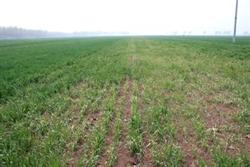Lodging control measures of wheat in spring

Lodging is one of the main factors affecting the high and stable yield and quality of wheat. Wheat lodging mainly occurs in high-yield wheat fields with sufficient fertilizer and water, prosperous growth of wheat, large population and cloudy field. Early spring is the key period to prevent wheat lodging. The comprehensive anti-lodging technical measures are as follows: scientific operation of high-yield wheat fields of more than 650000 mu in the period of returning fertilizer and water to green, topdressing and watering the first Internode of wheat (that is, the later stage of jointing), topdressing and applying 7.5-10kg urea per mu, which can not only reduce ineffective tiller, reduce basal Internode length, promote stem stout, prevent late lodging, but also increase the number of grains per spike and improve quality. Deep hoe cutting root and deep middle tillage is an important measure to control population and prevent lodging. For wheat fields with large population (more than 900000 high-yield wheat fields per mu during the rising period), ploughing 8-10 cm deep before and after getting up, cutting off floating roots, inhibiting small tillers, promoting the growth of main stems and large tillers, accelerating polarization, postponing ridge closure, and promoting healthy growth of plants. In the wheat field with larger population and higher plant, in addition to controlling green fertilizer and water and deep ploughing, proper suppression should be carried out before jointing to promote the root system to tie down, squat the basal Internode of the stem and reduce the plant height. The crackdown on the growth of visual prosperity was carried out for 2 to 3 times, each time at an interval of about 4 days, and the principle of "no pressure on wet, morning and cloudy days" should be grasped during the crackdown. Chemical control is one of the effective measures to prevent wheat lodging. For large and prosperous wheat fields or higher plant varieties, 15% paclobutrazol 30g / mu or 20% Zhuangfengan EC 30g / mu was sprayed with 30g / mu of 15% paclobutrazol or 20% Zhuangfengan EC at the starting stage of wheat. Spray 30kg of water to control plant growth, shorten basal internodes, reduce plant height, improve root activity, and enhance lodging resistance.
- Prev

Factors affecting Maize yield
Factors affecting Maize yield
- Next

Field Management techniques of Dryland Wheat in Spring
First, the cause of wheat seedling death in winter and spring 1. Internal cause refers to the ability of wheat plants to withstand cold and drought. Varieties with poor cold resistance are easy to cause dead seedlings. Individual sowing early, pre-winter ear differentiation to two-ridge stage of wheat seedlings, cold tolerance weakened, freezing injury often seriously killed seedlings, some late weak seedlings, their own accumulation.
Related
- The first cup of black tea in spring, the flavor and history of tea gardens in Kenya, Africa
- The computer can not only choose potatoes, but also grow tea rice. AI will grow winter oolong tea champion.
- It is not only the inflated tea bitten by insects, but also engraved with the four seasons tea in Beipu.
- The Oriental Beauty Tea Festival in Zhuxian County takes the stage at the weekend to experience the plus-size feast of oil tea.
- & quot; Oriental Beauty Tea & Exploration of Emei in Hsinchu, the hometown of quot;
- The new variety of strawberry "Tainong 1" dessert is the first choice with mellow aroma. Crimson gorgeous
- History of Tea in Taiwan: from Wild Inner Mountain to Export Tea Garden
- Two types of Taiwan Oriental Beauty Black Tea won the British three-Star Award for Childhood Tea Xiang Zhang Jiaqi changed from pilot to champion tea maker.
- Banana species and varieties: the planting history of Taiwan Xianren banana and dwarf banana is long, is banana disease resistant?
- Coffee planting Technology: Qianjie Coffee from Seedling to harvesting

